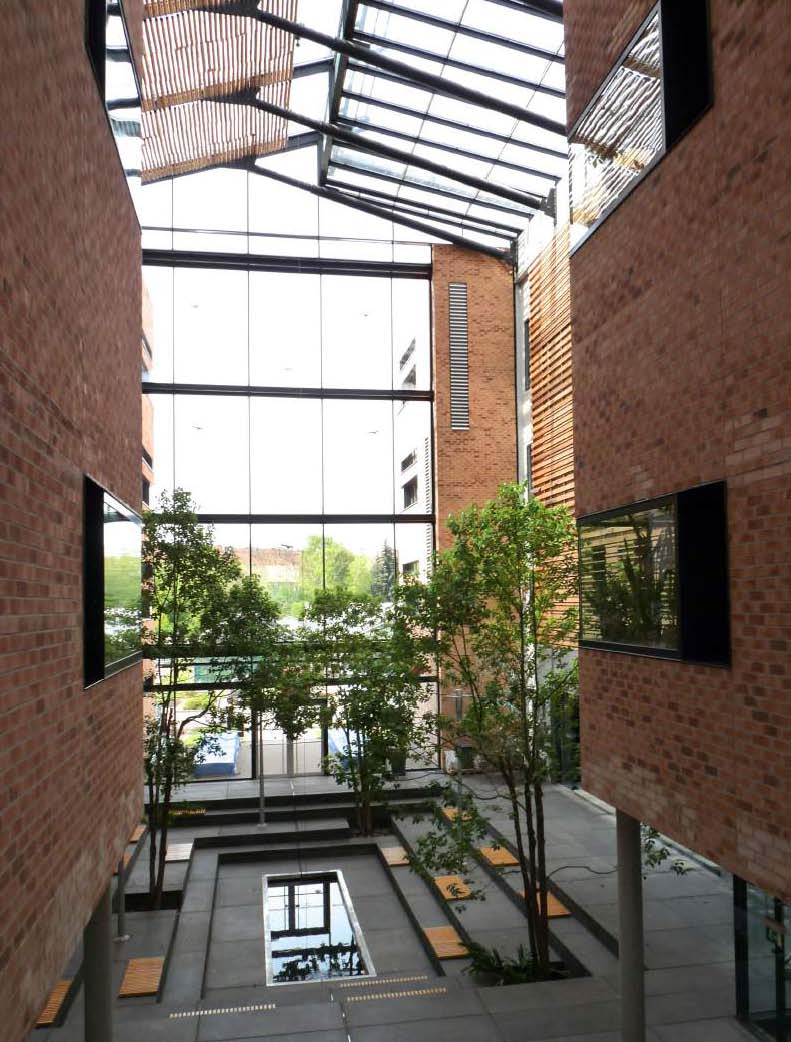em. Prof. Dr. Ulla Bonas

Institute of Biology, Dept. of Genetics
Martin Luther University
Halle-Wittenberg
em. Prof. Dr. habil. Ulla Bonas
Weinbergweg 10
D-06120 Halle (Saale)
Germany
Phone: +49- 345- 552 6290
Fax: +49- 345- 552 7277
E-mail: ulla.bonas@genetik.uni-halle.de
This site contents:
Forschung
Plant pathogens use sophisticated strategies to infect their host plants. Our model organism is Xanthomonas campestris pv. vesicatoria (Xcv), the causal agent of bacterial spot disease of pepper and tomato. Essential for Xcv pathogenicity is a type III secretion system that translocates bacterial effector proteins (T3Es) into the plant cell. Once inside the plant cell T3Es interfere with plant cell signaling and metabolic pathways to the benefit of the pathogen, which in turn can multiply in the intercellular spaces of the plant tissue. The effectors contribute to the virulence of the bacterium, e.g., by suppression of plant defense responses. Our key objectives are to identify and characterize novel bacterial virulence factors and to study the corresponding plant processes in disease and defense. To date, more than thirty T3Es have been confirmed experimentally. Our long-term goal is the analysis of interesting T3ES with respect to their localization in the plant cell and their potential effect on plant immunity, gene expression and other aspects that might be important during infection, e.g., plant protein secretion and plant cell structure.
Resistant tomato and pepper lines specifically recognize certain "injected" bacterial effector proteins that were designated "avirulence" proteins. For example, the AvrBs3 protein induces a hypersensitive reaction (HR) in pepper plants carrying the dominant resistance gene Bs3. The HR is a rapid, localized cell death reaction of the infected plant tissue. In susceptible pepper plants, i.e., in the absence of recognition, AvrBs3 induces hypertrophy (cell enlargement), which reflects the virulence function of AvrBs3. Hypertrophy also occurs in tomato and other solanaceous plants. AvrBs3 was the first TAL-effector identified (Bonas et al. 1989). Using immunocytology we have shown that AvrBs3 localizes to the plant nucleus. Where it acts as a transcription factor. Its activity depends on a central region of 34-amino acid repeats, nuclear localization signals and an acidic activation domain in the C-terminus. The repeat region turned out to be a novel DNA-binding motif, with one repeat binding one DNA-basepair (Boch et al. 2009).
Awards:
Bundesverdienstkreuz am Bande 2019
Die Pflanzengenetikerin Prof. Dr. Ulla Bonas ist heute in Magdeburg mit dem Bundesverdienstkreuz am Bande geehrt worden. Gewürdigt wurden mit dem von Bundespräsident Dr. Frank-Walter Steinmeier verliehenen Orden ihre Verdienste um die Wissenschaftslandschaft in Sachsen-Anhalt, teilte die Staatskanzlei mit. Die 63-Jährige habe zudem über viele Jahre die Nationale Akademie der Wissenschaften Leopoldina unterstützt. „Sie haben den Ruf Sachsen-Anhalts als Land der Forschung gestärkt. Vor allem aber haben Sie durch Ihre unbestechliche Wahrheitsliebe Maßstäbe gesetzt und dadurch bleibende Verdienste erworben“, sagte Sachsen-Anhalts Ministerpräsident Dr. Reiner Haseloff, der den Orden überreichte. Seit 1998 hat Ulla Bonas die Professur für Genetik an der Universität Halle inne, im Jahr 2011 wurde ihr der Gottfried Wilhelm Leibniz-Preis verliehen. Heute ist Bonas Vizepräsidentin der Leopoldina, seit Oktober 2018 wirkt sie zudem als Wissenschaftliche Direktorin des Alfried Krupp Wissenschaftskollegs Greifswald.
Gottfried Wilhelm Leibniz-Preis 2011
Ulla Bonas received 2011 the Leibniz-prize from the German research foundation (DFG). The prize recognized the exciting work of her lab on the interaction between the plant pathogenic bacterium Xanthomonas campestris pv. vesicatoria and its host plants pepper and tomato. A major focus over the last 25 years in her laboratory was the effector protein AvrBs3 from Xanthomonas which is injected into plant cells via the type III secretion system. After import into the plant cell’s nucleus AvrBs3 binds to promoters of target genes thus manipulating plant gene expression. In susceptible plants, the developmental program is altered leading to cell enlargement and pustules on the leaf surface. By contrast, in Bs3 (italics) resistant pepper plants, AvrBs3 activates a suicide gene which results in plant cell death and the arrest of bacterial multiplication. In a series of seminal papers the biochemical function of AvrBs3 has been elucidated. The findings have not only provided new insights into the mechanism of host-pathogen interactions but also opened new avenues for biotechnology.
http://www.dfg.de/en/funded_projects/prizewinners/leibniz_prize/2011/bonas/index.html
Memberships and professional activities
|
2005 - 2016 Spokesperson of the SFB 648 “Molecular mechanisms of information processing in plants” |
|
Member of:
|
| Since 2015: Vice president of the German National Academy of Sciences Leopoldina |
| Since 10/2018: Academic Director of the Institute for Advanced Studies (Krupp-Kolleg) in Greifswald |
CV Prof. Dr. Ulla Bonas
Letzte Publikationen und Patente
Ordon, Martin, Erickson, Ferik, Balcke, Bonas, Stuttmann*: Disentangling cause and consequence: Genetic dissection of the DANGEROUS MIX2 risk locus, and activation of the DM2h NLR in autoimmunity. Plant Journal (2021) https://doi.org/10.1111/tpj.15215
Stuttmann*, Barthel, Martin, Ordon, Erickson, Herr, Ferik, Kretschmer, Berner, Keilwagen, Marillonnet, Bonas: Highly efficient multiplex editing: One-shot generation of 8x Nicotiana benthamiana and 12x Arabidopsis mutants. Plant Journal (2021) https://doi.org/10.1111/tpj.15197
Ordon, Martin, Erickson, Ferik, Balcke, Bonas, Stuttmann*: Disentangling cause and consequence: Genetic dissection of the DANGEROUS MIX2 risk locus, and activation of the DM2h NLR in autoimmunity. Plant Journal (2021) https://doi.org/10.1111/tpj.15215
Schreiber T, Prange A, Hoppe T, Tissier A (2019) Split-TALE: A TALE-Based Two-Component System for Synthetic Biology Applications in Planta. Plant Physiology doi: 10.1104/pp.18.01218
Prochaska H, Thieme S, Daum S, Grau J, Schmidtke C, Hallensleben M, John P, Bacia K and Bonas U (2018) A conserved motif promotes HpaB-regulated export of type III effectors from Xanthomonas. Molecular Plant Pathology doi: 10.1111/mpp.12725
Jessica L. Erickson, Norman Adliung, Christina Lampe, Ulla Bonas, Martin H. Schattat (2018) The Xanthomonas effector XopL uncovers the role of microtubules in stromule extension and dynamics in Nicotiana benthamiana. Plant J doi: 10.1111/tpj.13813
Abendroth U, Adlung N, Otto A, Grüneisen B, Becher D and Bonas U (2017) Identification of new protein-coding genes with a potential role in the virulence of the plant pathogen Xanthomonas euvesicatoria. BMC Genomics: in press
Adlung N and Bonas U (2017) Dissecting virulence function from recognition – cell death suppression in Nicotiana benthamianaby XopQ/HopQ1-family effectors relies on EDS1-dependent immunity. Plant J doi: 10.1111/tpj.13578
Adlung N, Prochaska H, Thieme S, Banik A, Blüher D, John P, Nagel O, Schulze S, Gantner J, Delker C, Stuttmann J und Bonas U (2016) Non-host resistance induced by the Xanthomonaseffector XopQ is widespread within the genus Nicotiana and functionally depends on EDS1. Front Plant Sci 7: 1796, doi: 10.3389/fpls.2016.01796
Schreiber T, Sorgatz A, List F, Blüher D, Thieme S, Wilmanns M and Bonas U (2015) Refined requirements for protein regions important for activity of the TALE AvrBs3. PLoS One 17: e0120214
Müller OA, Grau J, Thieme S, Prochaska H, Adlung N, Sorgatz A and Bonas U (2015) Genome-wide identification and validation of reference genes in infected tomato leaves for quantitative RT-PCR analyses. PLoS ONE 10: e0136499. doi: 10.1371/journal.pone.0136499
Schreiber T, Bonas U. (2014) Repeat 1 of TAL effectors affects target specificity for the base at position zero. Nucleic Acids Res. 42(11):7160-9
Abendroth U, Schmidtke C, Bonas U. (2014) Small non-coding RNAs in plant-pathogenic Xanthomonas spp. RNA Biol. 11(5):457-63
Link to abstract on Pubmed
Schmidtke C, Abendroth U, Brock J, Serrania J, Becker A and Bonas U (2013) Small RNA sX13: a multifaceted regulator of virulence in the plant pathogen Xanthomonas. PLoS Pathog 9: e1003626
Grau J, Wolf A, Reschke M, Bonas U, Posch S and Boch J (2013) Computational Predictions Provide Insights into the Biology of TAL Effector Target Sites. PLoS Comput Biol 9: e1002962
Link to abstract on Pubmed
Singer AU, Schulze S, Skarina T, Xu X, Cui H, Eschen-Lippold L, Egler M, Srikumar T, Raught B, Lee J, Scheel D, Savchenko A, Bonas U. (2013) A pathogen type III effector with a novel E3 ubiquitin ligase architecture. PLoS Pathog 9: e1003121
Link to abstract on Pubmed
Schulze S, Kay S, Büttner D, Egler M, Eschen-Lippold L, Hause G, Krüger A, Lee J, Müller O, Scheel D, Szczesny R, Thieme F and Bonas U (2012) Analysis of new type III effectors from Xanthomonas uncovers XopB and XopS as suppressors of plant immunity. New Phytol. 195: 894 – 911
Schmidtke C, Findeiß S, Sharma CM, Kuhfuß J, Hoffmann S, Vogel J, Stadler PF and Bonas U (2012) Genome-wide transcriptome analysis of the plant pathogen Xanthomonas identifies sRNAs with putative virulence functions. Nucleic Acids Res 40: 2020-2031
Link to abstract on Pubmed
Geißler R, Scholze H, Hahn S, Streubel J, Bonas U, Behrens S E and Boch J (2011) Transcriptional activators of human genes with programmable DNA-specificity. PLoS One 6: e19509
Szczesny R, Jordan M, Schramm C, Schulz S, Cogez V, Bonas U and Büttner D (2010) Functional characterization of the Xcs and Xps type II secretion ATPase HrcN from the plant pathogen Xathomonas campestris pv. vesicatoria. New Phytologist 187: 983-1002
Szczesny R, Büttner D, Escolar L, Schulze S, Seiferth A and Bonas U (2010) Suppression of the AvrBs1-specific hypersensitive response by the YopJ effector homolog AvrBsT from Xanthomonas depends on a SNF1-related kinase. New Phytologist 187: 1058-1074
Link to abstract on Pubmed
Findeiß S, Schmidtke C, Stadler PF and Bonas U (2010) A novel family of plasmid-transferred anti-sense ncRNAs. RNA Biology 7: 1-5
Link to abstract on Pubmed
Boch J, Scholze H, Schornack S, Landgraf A, Hahn S, Kay S, Lahaye T, Nickstadt A, Bonas U (2009) Breaking the code of DNA-binding specificity of TAL-type III effectors. Science 326: 1509-12
Römer P, Strauss T, Hahn S, Scholze H, Morbitzer R, Grau J, Bonas U, Lahaye T (2009) Recognition of AvrBs3-Like Proteins is mediated by specific binding to promoters of matching pepper Bs3 Alleles. Plant Physiol 150: 1697-1712
Link to abstract on PubMed
Kay S, Hahn S, Marois E, Wieduwild R, Bonas U (2009) Detailed analysis of the DNA recognition motifs of the Xanthomonas type III effectors AvrBs3 and AvrBs3Deltarep16. Plant J 59: 859-871
Link to abstract on PubMed
Gürlebeck D, Jahn S, Gürlebeck N, Szczesny R, Szurek B, Hahn S, Hause G, Bonas U (2009) Visualization of novel virulence activities of the Xanthomonas type III effectors AvrBs1, AvrBs3 and AvrBs4. Mol Plant Pathol 10: 175-188
Link to abstract on PubMed
Lorenz C, Schulz S, Wolsch T, Rossier-Conway O, Bonas U, Büttner D (2008) HpaC controls substrate specificity of the Xanthomonas type III secretion system.
PLoS Pathogens 4: e1000094
Link to abstract on PubMed
Lorenz C, Kirchner O, Egler M, Stuttmann J, Bonas U, Büttner D (2008)
HpaA from Xanthomonas is a regulator of type III secretion. Mol Microbiol 69: 344-360
Link to abstract on PubMed
- Selected older publications
Kay S, Hahn S, Marois E, Hause G, Bonas U (2007).
A bacterial effector acts as a plant transcription factor and induces a cell size regulator. Science 318: 648-651
Link to abstract on Science
Link to abstract on PubMed
Römer P, Hahn S, Jordan T, Strauß T, Bonas U, Lahaye T (2007) .
Plant pathogen recognition mediated by promoter activation of the Pepper Bs3 resistance gene. Science 318: 645-648
Link to abstract on Science
Link to abstract on PubMed
Van den Ackerveken G, Marois E, Bonas U (1996)
Recognition of the bacterial avirulence protein AvrBs3 occurs inside the host plant cell. Cell 87: 1307-1316
Link to abstract on Pubmed
Herbers K, Conrads-Strauch J, Bonas U (1992)
Race-specificity of plant resistance to bacterial spot disease determined by repetitive motifs in a bacterial avirulence protein. Nature 356: 172-174
- Patents
Bonas U, Boch J, Schornack S and Lahaye T (2010) Modular DNA-binding domains and methods of use.
Lahaye T, Römer P, Schornack S, Boch J and Bonas U (2010) Pathogen-inducible promoters and their use in enhancing the disease resistance of plants.
Bonas U, Lahaye T and Römer P. (2008) Bs3 resistance gene and methods of use.
Büttner D and Bonas U (2004). Bacterial system for protein transport in eukaryotic cells.





